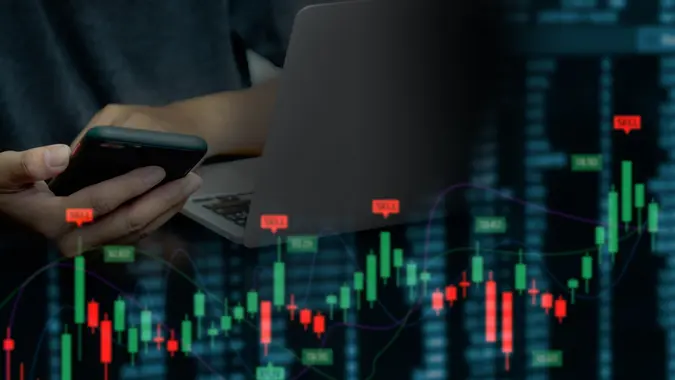What Is a Digital Asset?

Commitment to Our Readers
GOBankingRates' editorial team is committed to bringing you unbiased reviews and information. We use data-driven methodologies to evaluate financial products and services - our reviews and ratings are not influenced by advertisers. You can read more about our editorial guidelines and our products and services review methodology.

20 Years
Helping You Live Richer

Reviewed
by Experts

Trusted by
Millions of Readers
Digital assets are everywhere — whether it’s cryptocurrency or personal photos. Understanding what all qualifies as a digital asset, how they work and ways to protect them can help you make the most of any that you own.
What Is a Digital Asset?
A digital asset is anything that holds or creates value and is stored electronically.
Types of Digital Assets
Digital assets cover a wide range of valuable items, including:
Cryptocurrency
Cryptocurrencies, like bitcoin and ethereum, only exist digitally and require a cryptocurrency wallet to use them. A crypto wallet, which is also non-tangible, is where you store the encryption keys that confirm your identity and provide a link to your cryptocurrency assets. It’s important to use a trustworthy wallet to protect your investments. Otherwise, it could be hacked.
Digital Documents
Storing documents digitally secures them and makes them readily accessible at any time, which is a lot easier than the hassle of digging through boxes or filing cabinets. Additionally, digital storage can save a lot of physical space.
Business examples of digital documents include contracts, financial records, invoices and files. Personal examples include tax returns, medical records and loan agreements. You may also want to create digital documents from physical documents, such as birth certificates, passports, transcripts, titles or deeds.
Multimedia Files
Multimedia files, which include photos, videos, animations and audio recordings, are what companies may use for branding and marketing companies and what individuals use to capture memories or save personal content.
Intellectual Property
Intellectual property includes patents, trademarks and copyrights, including industrial designs, logos and music. Intellectual property often holds more worth than physical assets and deserves careful protection.
Non-Fungible Tokens
Non-fungible tokens are unique digital items that are often tied to art, music or in-game items. Unlike cryptocurrencies, each NFT is one-of-a-kind and cannot be exchanged for another at equal value.
Why Digital Assets Matter
Although digital assets can be beneficial to individuals by helping them preserve valuable content, they are a must-have for businesses. Here are some reasons why:
- Help establish and maintain brand identity
- Streamline processes and increase efficiency
- Increase asset security
- Support collaboration between team members
How To Manage Digital Assets
Managing digital assets requires specialized tools and knowledge of best practices. Here’s an overview of the software tools you’ll need to manage digital assets.
Brand Asset Management
BAM software helps companies manage assets related to their brand, such as logos, images and marketing materials, and helps maintain the brand’s consistent use across teams and campaigns.
Production Asset Management
In industries like film, gaming and animation, PAM software does the heavy lifting when it comes to managing assets during production and editing. PAM is designed for content that frequently changes. The software allows for easy tracking and updates, which helps teams stay organized during each stage of a project.
Library Asset Management
LAM software is designed for assets that don’t need regular updating, like archived files and reference materials. It helps keep assets organized, easy to find and ready to retrieve whenever they are needed.
Digital Asset Management: Best Practices
Here are seven best practices related to digital asset management:
- Define clear goals: Start by identifying exactly what you need from a DAM system — whether it’s streamlining workflows, managing brand consistency or keeping files organized.
- Audit existing assets: Take the time to review your current digital assets before setting up a new system to help create an organized structure from the beginning. Sort assets by type, eliminate outdated files and set up categories so everything is easy to find.
- Set up user access and permissions: A DAM system can control who can access, edit and share files. Set up user access permissions to ensure that only those who need specific content can see or work on it, which will keep your assets secure while still allowing collaboration.
- Consistent naming and metadata: Create simple naming conventions and metadata standards to make files searchable and organized. Additionally, include project names, file types and tags in each file’s metadata to help teams find what they need quickly while also allowing easy tracking.
- Appoint a digital asset manager: To keep the DAM system organized and running efficiently, you’ll need to appoint a digital asset manager. Duties include organizing files, updating metadata, training team members and granting users access.
- Implement security standards: Keep digital assets safe by using security tools like encryption, firewalls and multi-factor authentication. Add digital rights management — aka DRM — to help protect intellectual property and ensure content complies with copyright regulations.
- Routine DAM updates: Regularly review and update your DAM system to ensure that assets remain organized and relevant. Additionally, conduct quarterly audits that will allow you to remove outdated content and verify accuracy, while keeping only approved assets available for use.
Takeaway
Digital assets play an important role in both personal and business settings — from family photos to intellectual property. With the right tools and practices in place, you can keep your digital assets secure, organized and accessible.
FAQ
Here are the answers to some of the most frequently asked questions about digital assets.- What are some examples of digital assets?
- Digital assets include cryptocurrency, multimedia files, intellectual property and digital documents.
- What does the IRS consider a digital asset?
- According to the IRS, it views digital assets as property, not currency, for tax purposes. It defines a digital asset as anything stored electronically that can be bought, sold, owned, transferred or traded.
- How do digital assets make money?
- You can make money with digital assets by creating and selling them, such as an online course, ebook or printable, or by trading them, as in the case of cryptocurrencies or NFTs.
Our in-house research team and on-site financial experts work together to create content that’s accurate, impartial, and up to date. We fact-check every single statistic, quote and fact using trusted primary resources to make sure the information we provide is correct. You can learn more about GOBankingRates’ processes and standards in our editorial policy.
- Coinbase. "What are digital assets?"
- Cloudinary. "Unlocking the Power of Digital Assets: 5 Key Reasons They Matter."
- Forbes. 2024. "What Is An NFT? Non-Fungible Tokens Explained."
- Cloudinary. "The Top 7 Best Digital Asset Management Tools."
- Brandfolder. 2023. "13 Key Digital Asset Management Best Practices for 2024."
- IRS. 2024. "Digital assets."
 Written by
Written by  Edited by
Edited by 

























